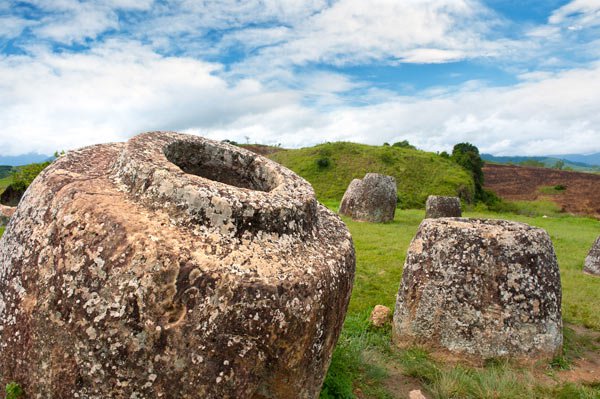
The Plain of Jars is a famous cultural heritage of Laos on the Xiengkhoang Plateau. There are thousands of stone jars weighing from 600 kg to 1 ton scattered on fields along the northern border of the Truong Son range.
The Plain of Jars in Ban Ang is located on a hill, surrounded by sparse balmy forest, the far away is Truong Son range.
A field with large and small jars, the one lying alone, the jars lay sprawled on the arid soil about 25 hectares wide.
Ban Ang is the most famous place with 334 jars found, of which the largest is 2.5 m in diameter and 2.57 m high. Most of the jars have no lid, different square shaped shapes, the ones that stand perfectly on the ground, sink a part of the ground, there are jars that have broken, broken bottom or chipped.
History of the Plain of Jars
The legend of stone jars that these are wine brewing vessels that the ancient king Khun Cheung used to celebrate after the triumph.
Another suggested explanation for the jars’ use is to collect monsoon rainwater for caravan travelers along their journey at times when rain may have been seasonal and water was not readily available on the easiest footpaths. Rainwater would then be boiled, even if stagnant, to become potable again, a practice long understood in Eastern Eurasia. The trade caravans that camped around these jars could have placed beads inside them as offerings, accompanying prayers for rain. Or the beads might simply have been unassociated lost items.
However, archaeologists are inclined to assume that Plain of Jars is a huge cemetery, each of which is a jar used to bury a corpse. In 1930, French archaeologist Madeleine Colan conducted research around the Plain of Jars and discovered bones, teeth, pottery shards, and beads.
But from where and how these giant jars made of limestone, laterite and marble exist with only one place in the world This is still a mystery that challenges humanity.
Going between the Plain of Jars, we can touch the cold, rough rocks lying quietly on the gray burnt ground, challenging time and rain.
Visiting the Plain of Jar
A special thing when coming to Phonesavanh when visiting Plain of Jars is the images of bombs, mines displayed everywhere. This is like a reminder that in the past, this place suffered heavy war in the past. Scattered over the plains are literally thousands of tonnes of unexploded bombs, land mines and other unexploded military ordnance, which contaminate more than 35% of the province’s total land area and continue to threaten the lives of the 200,000 people who now live in Xieng Khouang.
Only seven of the 90 jar sites have been declared safe enough for tourists to visit: Site 1, Site 2, Site 3, Site 16, Site 23, Site 25, and Site 52.
- Site 1 is closest to town and receives the most visitors, but is not the best representation of the Plain of Jars.
- Site 2 is accessible from Site 1 by motorbike or tuk-tuk and then Site 3 can be reached by an easy hike.
- Site 52, the largest known site containing 392 jars, is rarely visited and can only be reached by foot. Always stay on the signed paths when walking between jar sites.
Getting There
The small town of Phonsavan is the capital of Xieng Khouang province and is the usual base for visiting the Plain of Jars.
By Plane: Lao Airlines has several flights a week from Vientiane to Phonsavan’s Xiang Khouang Airport (XKH).
By Bus: Daily buses run between Phonsavan and Vang Vieng (eight hours), Luang Prabang (eight hours), and Vientiane (eleven hours).
By Private Car: Hire a private car could excellent choice if you’ve already got a group of friends ready for a day of adventures. With this option, you’ll generally arrive in the comfort of your air-conditioned van with a private driver, and you’ll enjoy more flexibility in deciding what time you’d like to leave the falls again. Contact us to get car rental service in Laos with best price
